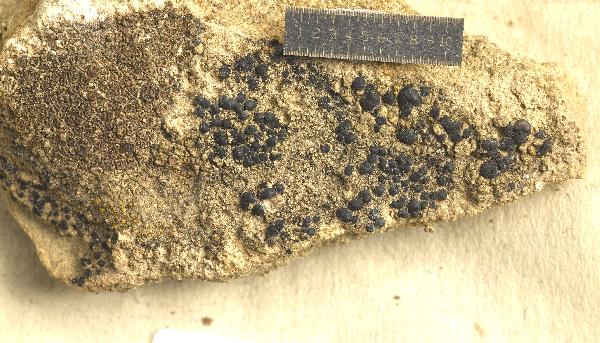Acarospora paupera H. Magn.
K. svenska Vetensk-Akad. Handl., Ser. 3, 7, 4: 167, 1929
Synonyms: Acarospora tongletii var. paupera (H. Magn.) Clauzade & Cl. Roux
Distribution: N - Piem (TO 509), Lig.
Description: Thallus crustose, episubstratic, rimose-areolate, well delimited, whitish, grey to yellowish brown, the areoles small, usually not well-visible because hidden by the numerous apothecia. Algal layer discontinuous, interrupted by vertically oriented hyphal bundles. Apothecia lecanorine, 0.2-0.6 mm across, 1-3(-5) per areole, at first immersed, then more or less projecting, round to angular or slightly elongated, sometimes confluent, with a concave, smooth to slightly rugose, dark brown disc and a prominent, entire thalline margin. Epithecium yellowish brown, K+ yellow turning red (needle-like crystals); hymenium colourless, 60-120(-130) μm high; paraphyses 1.5-2 μm thick at base, the apical cells 3-5 μm wide; hypothecium colourless, K-. Asci 100-200-spored, clavate, the apical dome K/I-. Ascospores 1-celled, hyaline, ellipsoid to subcylindrical, 3-6.5 x 1.5-2 μm. Photobiont chlorococcoid. Spot tests: thallus K-, C-, KC-, P-, UV-; but thalline margin of apothecia and epithecium K+ yellow turning red (needle-like red crystals). Chemistry: thallus without lichen substances; apothecia (epithecium and thalline margin) with norstictic acid.Note: a temperate to boreal-montane, probably circumpolar species, in Italy most frequent on base-rich sandstone walls, but much overlooked.
Growth form: Crustose
Substrata: rocks
Photobiont: green algae other than Trentepohlia
Reproductive strategy: mainly sexual
Commonnes-rarity: (info)
Alpine belt: absent
Subalpine belt: extremely rare
Oromediterranean belt: absent
Montane belt: very rare
Submediterranean belt: very rare
Padanian area: extremely rare
Humid submediterranean belt: very rare
Humid mediterranean belt: absent
Dry mediterranean belt: absent

Predictive model
Herbarium samples
Growth form: Crustose
Substrata: rocks
Photobiont: green algae other than Trentepohlia
Reproductive strategy: mainly sexual
Commonnes-rarity: (info)
Alpine belt: absent
Subalpine belt: extremely rare
Oromediterranean belt: absent
Montane belt: very rare
Submediterranean belt: very rare
Padanian area: extremely rare
Humid submediterranean belt: very rare
Humid mediterranean belt: absent
Dry mediterranean belt: absent

Predictive model
| Herbarium samples |
 INDEX FUNGORUM
INDEX FUNGORUM
 GBIF
GBIF


